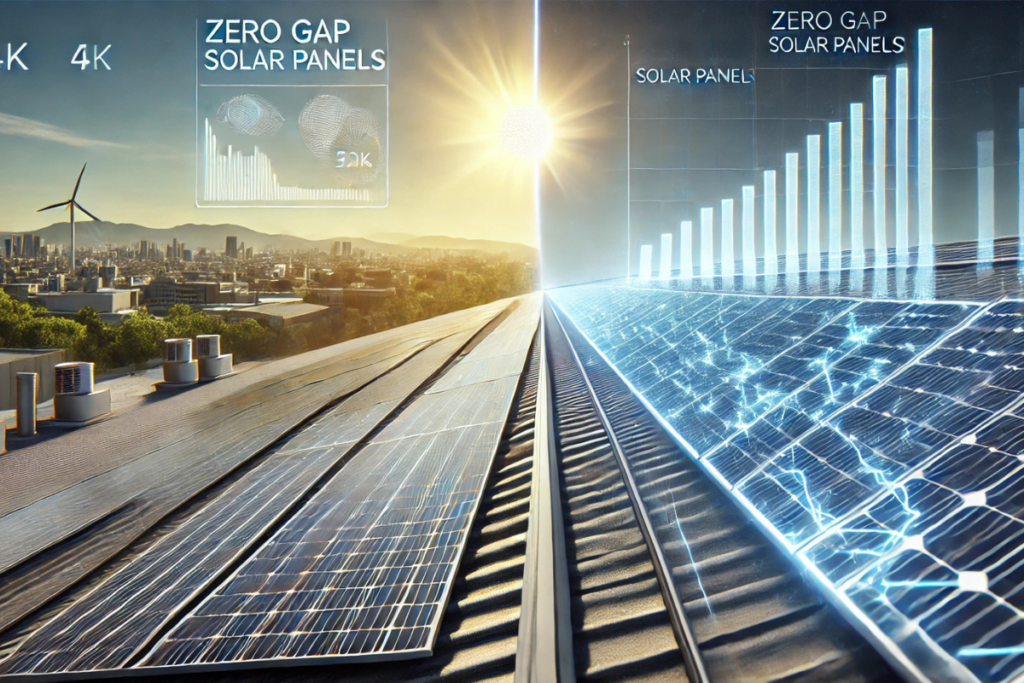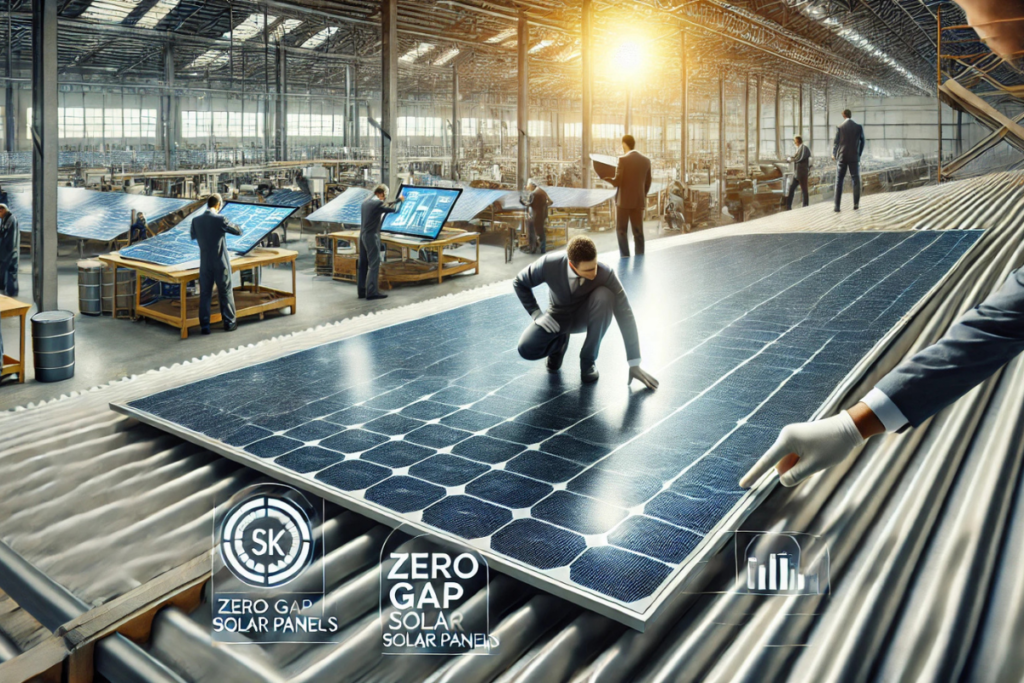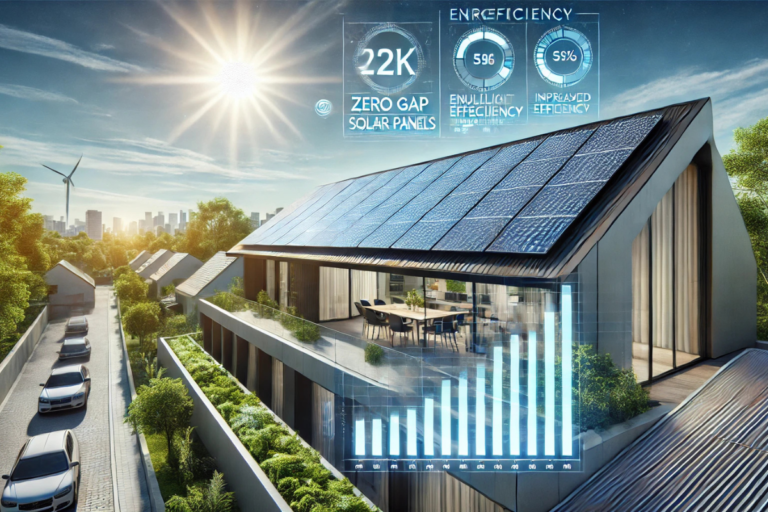Introduction to Zero Gap Solar Panels
Zero gap solar panels are a modern advancement in solar energy technology. They are designed to eliminate the spaces between solar cells, creating a seamless and compact panel surface. This innovative design helps capture more sunlight and boosts the overall efficiency of solar panels.
In traditional solar panels, small gaps exist between the solar cells. These gaps reduce the amount of sunlight captured by the panel, which leads to lower energy output. Over time, experts realized that these spaces were a major limitation. Zero gap technology was developed to solve this problem, offering a smarter and more effective way to harness solar energy.
Zero gap solar panels are important because they produce more energy from the same surface area compared to traditional designs. They are also space-saving, making them a great choice for people with limited roof space or businesses that need maximum energy efficiency.
This new design is not just about efficiency. It is also about sustainability. By using fewer materials and maximizing energy production, zero gap solar panels support eco-friendly energy solutions. They are paving the way for a greener and smarter future in renewable energy.
Evolution of Solar Panel Efficiency
Solar panel technology has come a long way since its invention. Early panels were bulky, inefficient, and expensive. They could convert only a small percentage of sunlight into electricity. Over the years, researchers and engineers have made great advancements to improve their performance and accessibility.
In the beginning, solar panels used basic silicon cells. These panels were only about 5% efficient, which meant most of the sunlight was wasted. With time, new materials, better designs, and advanced manufacturing methods increased efficiency. Today, modern panels can convert 20-25% of sunlight into usable energy, a huge improvement.
One of the biggest breakthroughs in solar panel technology is how the cells are arranged. In traditional designs, solar cells are placed with small gaps between them. These gaps prevent some sunlight from being captured. Innovations like zero gap solar panels eliminate this issue. By arranging cells edge to edge, panels can capture more sunlight and produce more energy. This small design change has had a big impact on solar technology.
Advancements in solar efficiency also focus on durability and adaptability. Panels are now designed to work in different climates and withstand harsh weather conditions. This evolution has made solar energy more reliable and practical for homes, businesses, and large-scale projects.

Understanding Zero Gap Technology
Zero gap technology, also known as gapless design, is a modern innovation in solar panel construction. The term “zero gap” refers to the elimination of the spaces between individual solar cells on a panel. Instead of leaving small gaps, the cells are placed edge to edge, creating a smooth and continuous surface.
This design is significant because those tiny gaps in traditional panels reduce the panel’s ability to capture sunlight effectively. Sunlight hitting these gaps is wasted because it cannot be converted into energy. Zero gap solar panels solve this problem by ensuring every inch of the panel is utilized to absorb sunlight.
Eliminating gaps between cells increases energy output. With more surface area dedicated to energy production, these panels can generate more electricity from the same amount of sunlight. This improvement makes zero gap panels more efficient and productive compared to traditional designs.
Zero gap technology also helps reduce energy losses caused by shading or inefficient layouts. By optimizing the placement of solar cells, these panels make better use of available light. This simple but effective change is transforming how solar energy systems perform, providing higher returns for both homeowners and businesses.
Advantages of Zero Gap Solar Panels
Zero gap solar panels bring several important benefits to solar energy users. Their innovative design offers practical and financial advantages, making them a popular choice for those looking to maximize their energy production.
Improved Energy Conversion Rates
Zero gap solar panels have higher energy conversion rates compared to traditional panels. By eliminating gaps between solar cells, they capture more sunlight and turn it into usable electricity. This design ensures that no part of the panel goes unused, leading to better overall efficiency. With more energy generated, homeowners and businesses can rely less on the grid and save more on electricity bills.
Space Optimization and Higher Power Density
For people with limited space, zero gap panels are an ideal solution. Their compact design allows for maximum power generation in smaller areas. With higher power density, these panels can produce more electricity per square foot than conventional designs. This makes them perfect for rooftops, urban areas, or any location where space is a concern.
Potential Cost Savings in Installation and Materials
Zero gap panels can also reduce costs in the long run. Since they generate more power from the same surface area, fewer panels may be needed to meet energy needs. This means lower installation costs, as less hardware and labor are required. Additionally, the efficient use of materials in zero gap technology contributes to sustainability and long-term savings.
Leading Manufacturers and Innovations
Several companies are at the forefront of zero gap solar panel technology, introducing innovative products that enhance energy efficiency and performance.
Q CELLS’ Q.ANTUM DUO Z Technology
Q CELLS has developed the Q.ANTUM DUO Z technology, which features a zero-gap cell layout. This design increases module efficiency by up to 21.1%, as seen in their Q.PEAK DUO BLK ML-G10+ series.
LG’s NeON H+ Black Solar Panel
LG introduced the NeON H+ Black solar panel, utilizing gap-free technology. This panel achieves an output of 405 W and operates efficiently at higher temperatures, thanks to its n-type half-cut cells.
Sirius PV 410W Bifacial Solar Panel
Sirius PV offers a 410W bifacial solar panel with a zero-gap cell layout, resulting in module efficiency up to 21%. This design minimizes shading impact and enhances low-light performance, making it suitable for various projects.
These advancements by leading manufacturers demonstrate the industry’s commitment to improving solar panel efficiency and performance through zero gap technology.
Comparative Analysis: Zero Gap vs. Traditional Solar Panels
Zero gap solar panels are a significant improvement over traditional solar panel designs. Here is a detailed comparison of their efficiency, performance, installation, and aesthetics to help understand why zero gap technology stands out.
Efficiency Metrics and Performance Comparisons
Traditional solar panels leave small gaps between the cells, which reduce the overall efficiency. These gaps cause some sunlight to be lost as it cannot be converted into energy. On average, traditional panels have efficiency rates of around 17-20%.
Zero gap solar panels, however, eliminate these gaps, maximizing the surface area used to capture sunlight. With more light converted into energy, these panels can achieve efficiency rates of 21% or higher. This means higher energy output from the same panel size, making them ideal for homes and businesses looking for better performance.
Installation Considerations
Installation is another area where zero gap panels have an advantage. Since they produce more energy per square foot, fewer panels may be needed to meet the same energy demands. This reduces the labor, time, and cost associated with installation.
Traditional panels often require more space and hardware, especially for larger energy needs. This can lead to higher costs and more complex installations.
Aesthetic Differences
Zero gap solar panels also have a sleeker, more modern appearance. The edge-to-edge design creates a smooth, uniform look that blends well with rooftops. For homeowners and businesses focused on aesthetics, this can be an important factor.
Traditional panels, with visible gaps and larger frames, may not have the same visual appeal. They can look less streamlined, especially on smaller or highly visible installations.
Applications and Suitability
Zero gap solar panels are highly versatile, making them suitable for a wide range of applications. Their efficient design is especially valuable in scenarios where space is limited but maximum energy output is needed. For instance, they are ideal for small rooftops in urban areas, where optimizing every square foot is crucial. Projects that prioritize high energy efficiency or aesthetic appeal also benefit from zero gap panels due to their sleek and modern design.
These panels work well in residential settings, offering homeowners a way to reduce electricity costs while maximizing energy production from smaller roof spaces. In commercial applications, businesses can rely on zero gap solar panels to meet high energy demands, even on limited rooftop areas. They are also an excellent choice for utility-scale projects, as their ability to generate more electricity per square meter makes them a cost-effective solution for large solar farms. Their adaptability to various environments and needs ensures that zero gap solar panels are suitable for residential, commercial, and utility-scale energy projects alike.
Challenges and Considerations
While zero gap solar panels offer numerous benefits, they also come with certain challenges that need to be considered. One key challenge lies in their manufacturing process. The precision required to eliminate gaps between cells can make production more complex and costly. Advanced technologies and skilled labor are essential to ensure that the panels are assembled accurately without compromising their efficiency.
Deployment of zero gap panels may also present challenges, especially in custom installations. Their unique design might require specialized mounting systems or adjustments to standard installation practices, potentially increasing initial setup costs.
Maintenance is another important factor. Although zero gap solar panels are built to be durable, their compact design can make repairs or replacements of individual cells more difficult if damage occurs. Additionally, their seamless surface might require regular cleaning to maintain peak efficiency, as dirt or debris can more easily cover the entire panel.

Future Prospects and Industry Trends
The future of zero gap solar panels looks promising as ongoing research continues to refine and improve the technology. Scientists and manufacturers are exploring advanced materials and innovative cell designs to further increase efficiency and reduce production costs. Emerging technologies, such as perovskite-based cells, are being integrated with zero gap designs to push the boundaries of energy conversion rates even higher.
Market adoption of zero gap solar panels is expected to grow significantly in the coming years. As consumers and businesses prioritize efficiency and sustainability, the demand for these panels will likely increase. Governments and organizations worldwide are also promoting renewable energy through incentives and policies, which support the widespread use of advanced solar technologies like zero gap panels.
Forecasts suggest that as production becomes more streamlined and costs decrease, zero gap solar panels will become the standard choice for residential, commercial, and utility-scale projects. With their combination of high efficiency, space optimization, and aesthetic appeal, they are set to play a major role in shaping the future of solar energy.
Conclusion
Zero gap solar panels represent a significant leap forward in solar energy technology. By eliminating the gaps between solar cells, these panels maximize efficiency, optimize space, and offer a sleek, modern design. They are a practical solution for residential, commercial, and utility-scale projects, making them a versatile choice for various energy needs. Despite some challenges in manufacturing and maintenance, advancements in technology continue to make zero gap panels more accessible and reliable.
As the demand for renewable energy grows, zero gap solar panels are poised to become a key player in the industry. With ongoing research and increasing market adoption, they offer a glimpse into the future of solar energy—efficient, sustainable, and innovative. For anyone looking to invest in solar technology, zero gap panels present a smart and forward-thinking option that aligns with both environmental and energy goals.
Thank you for visiting our Blog! For more engaging content, please check out the related category.
